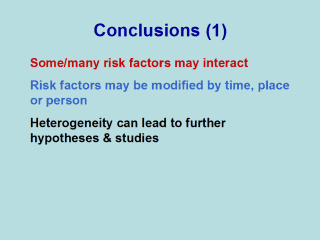 |
Many risk factors, mostly of small effect, have
been identified in schizophrenia epidemiology. But some – such as winter- or
urban-birth - may have a relatively high population attributable fraction.
Eg if a risk factor was weak (say a relative risk of 1.5-2.0) but prevalent
(say 40-70%), then this could account for up to 20% to 40% of all cases.
This means that if the underlying prevalent risk factor was removed then
this would prevent a substantial number of cases of schizophrenia from
occurring.
Risk factors may be modified by time place and person – such as season- or
place of birth or the individual’s sex; and there may be a relationship
between risk-factors.
|
